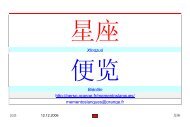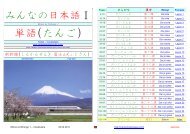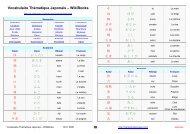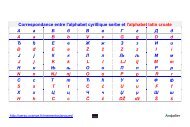Table de prononciation du Pinyin
Table de prononciation du Pinyin
Table de prononciation du Pinyin
Create successful ePaper yourself
Turn your PDF publications into a flip-book with our unique Google optimized e-Paper software.
Prononciation <strong>du</strong> <strong>Pinyin</strong><br />
http://escaleenchine.free.fr/<br />
<strong>Pinyin</strong> Tone Charts<br />
http://commons.wikimedia.org/wiki/Image:<strong>Pinyin</strong>_Tone_Chart.png<br />
http://commons.wikimedia.org/wiki/Image:Half-third_<strong>Pinyin</strong>_Tone_Chart.png<br />
Qu'est-ce que le pinyin ?<br />
Le pinyin est le système <strong>de</strong> transcription phonétique <strong>du</strong> chinois qui a été adopté par le<br />
gouvernement <strong>de</strong> RPC (République Populaire <strong>de</strong> Chine), puis à un niveau international.<br />
L'alphabet pinyin recourt aux 26 lettres <strong>de</strong> l'alphabet latin.<br />
Composition <strong>du</strong> pinyin<br />
Il comprend 7 voyelles : a, e, i, o, u, ü, ainsi qu'une voyelle sour<strong>de</strong> qui est représentée<br />
par un i.<br />
On ne peut pas confondre la voyelle sour<strong>de</strong> avec le i normal, puisque la voyelle sour<strong>de</strong><br />
n'apparaît qu'après <strong>de</strong>s consonnes qui ne peuvent pas être suivies d'un i normal : c, r,<br />
s, z, ch, sh, et zh.<br />
Les tons et leur représentation dans le pinyin<br />
Le chinois mandarin, ou putonghua (= langue commune), comporte 4 tons auxquels il<br />
faut ajouter un ton neutre. Ce ne sont pas <strong>du</strong> tout <strong>de</strong>s accents mais <strong>de</strong>s tons <strong>de</strong><br />
hauteur.<br />
Les tons sont représentés par <strong>de</strong>s signe placés au-<strong>de</strong>ssus <strong>de</strong>s voyelles <strong>du</strong> pinyin :<br />
1 2 3 4 5<br />
On écrira ainsi mā au premier ton, má au <strong>de</strong>uxième ton, mǎ au troisième ton, mà au<br />
quatrième ton et ma au ton neutre.<br />
Importance <strong>de</strong>s tons<br />
Suivre les tons est indispensable pour se faire comprendre en chinois.<br />
Cet exemple nous le prouve :<br />
- le caractère 妈 se prononce mā et signifie "maman"<br />
- le caractère 麻 se prononce má et signifie "chanvre, lin"<br />
- le caractère 马 se prononce mǎ et signifie "cheval"<br />
- le caractère 骂 se prononce mà et signifie "injurier"<br />
- le caractère 吗 se prononce ma et est une particule interrogative<br />
5<br />
4<br />
3<br />
2<br />
Les 4 tons<br />
3 è ton<br />
5<br />
4<br />
3<br />
2<br />
Le 3 è ton <strong>de</strong>vant les 1 er , 2 è et 4 è tons<br />
5<br />
4<br />
3<br />
2<br />
3 è ton<br />
5<br />
4<br />
3<br />
2<br />
1<br />
1<br />
1<br />
1<br />
Le 3 è ton se prononce au 2 è ton <strong>de</strong>vant un autre 3 è ton<br />
汉 语 拼 音 汉 语 4/4 拼 音
















